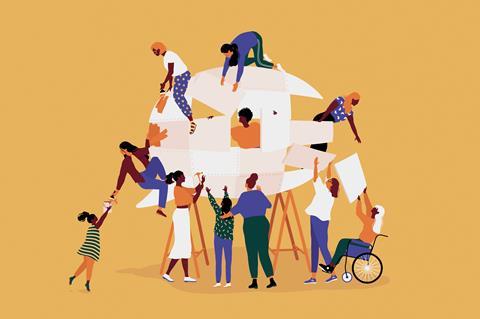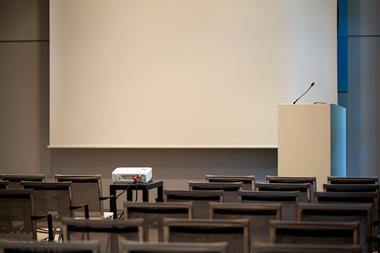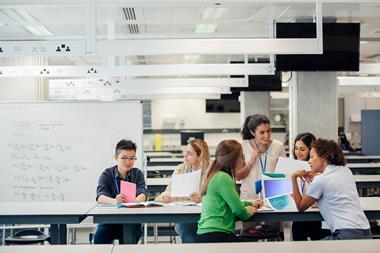And why it’s your responsibility too
Most of us know how beneficial scientific conferences are; as graduate students, we often make our first professional connections outside of our own department through such meetings. New collaborations develop, cutting edge research is announced and careers are made at meetings and conferences. Having access to these opportunities is critical to career advancement in the near and long term.
Unfortunately, scientific conferences are not equally accessible or welcoming to all. Not all venues are accessible to colleagues with physical disabilities, or have facilities that are safe for transgender attendees. Current and historical practices and structures that are part of scientific meetings often result in stereotype threat, instances of microaggressions, and overall feelings of exclusion.
For example, scientists who are new parents may find it difficult to attend or participate in all aspects of a meeting. Such participants struggle with an extra cognitive load and the financial burden of arranging for childcare on site or at home to be able to attend. This extra level of effort to participate can impact the way these scientists feel included in the meeting and are able to engage.
The participation and inclusion of colleagues from diverse backgrounds is morally imperative
In another example, the 2018 report Sexual Harassment of Women by the US National Academies of Sciences found that women working in science are more likely to suffer harassment, with higher incidence rates among those with intersectional identities, such as women of colour or LGBTQ women. As a result they may choose not to engage where these aggressions can happen easily, such as in field work situations or at conferences.
The participation and inclusion of colleagues from diverse backgrounds is morally imperative and critical to improving the quality of scientific discovery and understanding. Conferences are an important place to take steps towards inclusion. Such actions not only improve the experiences of everyone in attendance, but also serve as a mechanism to foster inclusion in science more broadly.
Diversity and inclusion matter
The scientific community still has an embarrassingly low level of participation from women, particular ethnic and racial groups, LGBTQ colleagues, scientists with disabilities, and others from historically marginalised social identities. The 2014 Royal Society report A Picture of the UK Scientific Workforce showed that those demographics are less likely to hold senior leadership roles in science occupations than colleagues from majority populations. In the UK, only 7.9% of chemistry professors in the UK are female. Only 2.9% of UK-based scientists come from ethnic minority backgrounds. This lack of representation is evident and even exacerbated in our professional meetings and conferences.
A rich body of research shows that diversity and inclusion leads to better, more creative science
Denying historically underrepresented colleagues full access and opportunities to participate in scientific exchange, mentoring and career advancement limits not only them, but the field as a whole. Exclusive practices mean we lose access to complex types of diversity such as knowledge practices (epistemic), values (axiological) and ways of being (ontological). These stem from the lived experiences of people who are physically and culturally different from one another, and provide rich ground in which innovation can thrive. A rich body of research now shows that diversity and inclusion leads to better, more creative science.1–3
To realise such potential, we need to redesign our scientific institutions and activities more broadly to create opportunities for all individuals to thrive in scientific exchange, mentoring and career advancement. In addition, we need to understand that broadening participation is both about increasing the numbers of diverse participants and ensuring that they can fully contribute their expertise.
Steps towards inclusive meetings
Today we are fortunate to have publications and resources for anyone wanting to understand more about the needs of underrepresented populations in science, technology, engineering and maths (Stem). To implement the needed changes, however, requires that we also challenge our own past norms and engage in evidence-based practices for creating positive experiences for a more diverse group of peers.
There are many actions before, during and after conferences that can drastically improve inclusivity (see box). The first step is to ensure that multiple perspectives are brought to bear on the way in which the meeting is designed by appointing an organising committee that reflects the diversity you are seeking.
We are all, whenever we attend a conference, responsible for enacting a culture shift towards inclusion
One way that conference organisers should remove barriers for attendance is by making sure the conference venue follows accessibility standards. Even if some venues have not updated their facilities, conference organisers can negotiate temporary fixes. For example, attendees of the 2019 annual conference of the Society for the Advancement of Chicanos and Native Americans in Science found temporary reassignment and signage of bathrooms to make them accessible and safe for all genders.

When planning the agenda of a scientific conference, a diverse speaker lineup should be prioritised. This is in recognition that whomever talks has the power. An equitable set of keynote speakers helps to advertise that the conference is welcoming and inclusive. Visual messaging is another crucial aspect of advertising to review. Nothing can be more counterproductive than a group photo of mostly able bodied, all white male attendees on a meeting website trying to solicit registrations from scientists from a wide range of backgrounds.
Clear messaging and support needs to continue throughout the conference. Opening remarks are important for setting an inclusive and welcoming tone, and can highlight and normalise the services available, such as quiet rooms or lactation rooms. In a similar vein, questions and discussions should be moderated in such ways that give equitable voice to participants regardless of career stage or social identities.
But it’s not just conference organisers who should work on making meetings more inclusive. We are all, whenever we attend a conference, responsible for enacting a culture shift towards inclusion. Each attendee has the opportunity – and arguably the responsibility – to treat all colleagues with openness, respect and collaboration. Actions you can take to support inclusion include being selective about which conferences you attend, prioritising those that demonstrate commitments to diversity and inclusion. Or you may choose to encourage conference organisers to adopt more inclusive practices. If you are unable to attend a meeting, you could recommend an alternate attendee who not only represents your area of scholarly expertise, but may also represent an underrepresented career stage or social identity.
In addition, we need scientific institutions, societies and organisations to foster a culture where colleagues are taught to lean in on issues of inequity to correct the harmful behavior of other colleagues. There are no bystanders: only those who are harmed, those who do the harm and those who let it be done.
Science is a team sport and meetings are our stadium
Such actions can significantly lessen the burden on those from underrepresented backgrounds, who often shoulder the work of advancing diversity and inclusion. We can only address underrepresentation and exclusion if we understand it as a collective problem that requires us all to commit to making conferences more creative and welcoming spaces. Science is a team sport and meetings are our stadium, and so it is critical we recruit and sustain diverse and complementary talents to avoid falling into rote patterns that lack innovation and inclusivity. Fostering diversity and inclusion in scientific meetings will enable a better scientific community, and thus better science.
The guide Inclusive Scientific Meetings: Where to Start4 provides anyone involved in organising scientific conferences with the knowledge and resources to make a difference, as well as background on the latest research on diversity, equity and inclusion in the Stem context. Written by a group of scientists and leaders in diversity, equity and inclusion in Stem, the guide was co-developed by 500 Women Scientists, the Earth Science Women’s Network, and the Aspen Global Change Institute. Some of the tips it shares for organising inclusive events include:
Pre-conference
Prioritise a diverse group of co-organisers, speakers and attendees
When organising keynotes, give female and underrepresented participants equitable standing with able-bodied, white men
Make sure your conference venue follows accessibility standards and has bathroom facilities for individuals from non-binary genders
Work with conveners to provide access to aid for travel and childcare
Review conference communications and advertising for inclusive language and visual messaging
Require attendees to agree to workshop rules of engagement and/or a code of conduct as part of registration
Ask for each participant’s preferred gender pronoun as part of registration, and include on official rosters and nametags
During the conference
Use opening remarks to set an inclusive tone, for example by highlighting and normalising some of the available support
Post and publicise the conference’s code of conduct around the venue
Identify staff or volunteers who can be contacted if the code of conduct is violated, and be clear about enforcement mechanisms
Establish equitable rules of engagement regarding discussion dynamics. How will questions be fielded?
Provide chairs for speakers and panellists
Use microphones and speakers during presentations and discussions to assist with auditory accessibility
Plan activities to help participants (especially those who are not already familiar with others in attendance) to connect with each other
After the conference
Create open opportunities for conference attendees to contribute to post-workshop publications
Ensure appropriate attribution of conference-generated ideas
Document results on the effectiveness of inclusion-promoting strategies and share them through published meeting notes. Highlight lessons learned, recognise challenges, celebrate successes and honour everyone’s efforts. The notes can also serve as a valuable example for peer institutions, and inspire a broader systemic change.
References
1 R B Freeman and W Huang, J. Labor Econ., 2015, 33, S289 (DOI: 10.1086/678973)
2 M W Nielsen et al, Proc. Natl Acad. Sci. USA, 2017, 114, 1740 (DOI: 10.1073/pnas.1700616114)
3 K W Phillips et al, Scientific American, 2014, 311, 42
4 A Pendergrass et al, Inclusive scientific meetings: Where to start, 500 Women Scientists, 2019












No comments yet